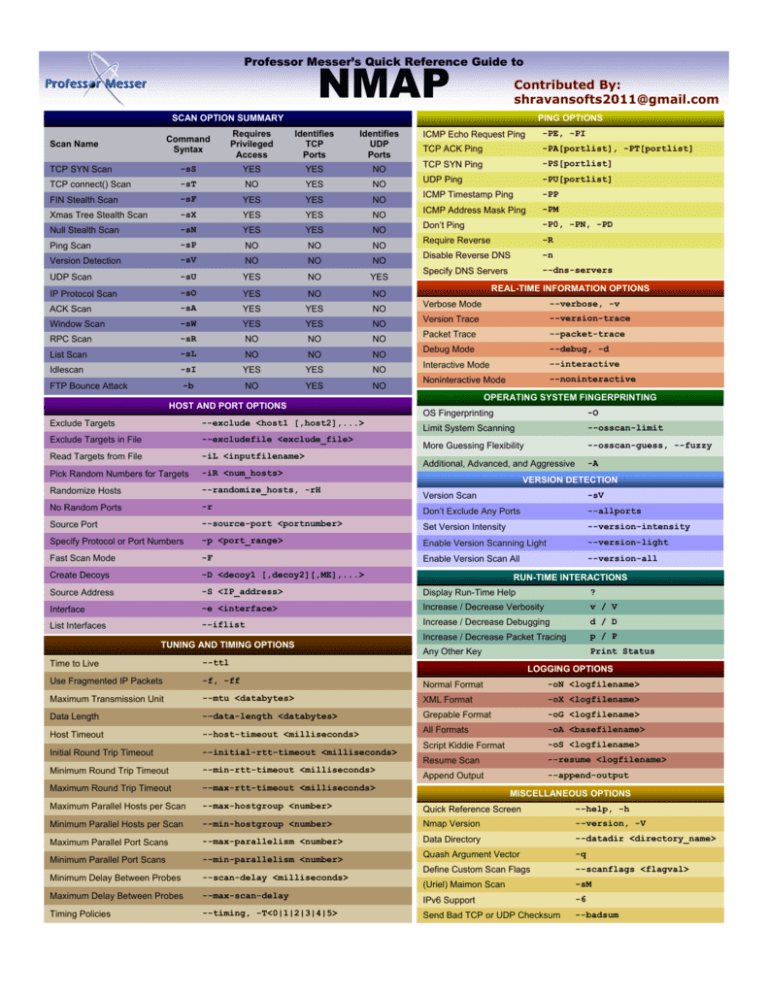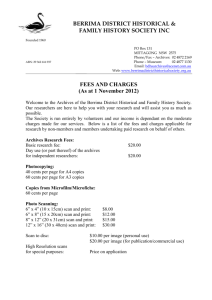
Professor Messer’s Quick Reference Guide to
NMAP
SCAN OPTION SUMMARY
Command
Syntax
Scan Name
Identifies
TCP
Ports
Identifies
UDP
Ports
YES
YES
NO
-sS
TCP SYN Scan
-sT
TCP connect() Scan
NO
-sF
FIN Stealth Scan
YES
-sX
Xmas Tree Stealth Scan
YES
-sN
Null Stealth Scan
YES
-sP
Ping Scan
NO
-sV
Version Detection
PING OPTIONS
Requires
Privileged
Access
NO
YES
NO
YES
NO
YES
NO
YES
NO
NO
NO
NO
NO
UDP Scan
-sU
YES
NO
YES
IP Protocol Scan
-sO
YES
NO
NO
-sA
ACK Scan
YES
-sW
Window Scan
YES
-sR
RPC Scan
NO
-sL
List Scan
NO
-sI
Idlescan
YES
-b
FTP Bounce Attack
NO
YES
NO
YES
NO
NO
NO
NO
NO
YES
NO
YES
NO
ICMP Echo Request Ping
-PE, -PI
TCP ACK Ping
-PA[portlist], -PT[portlist]
TCP SYN Ping
-PS[portlist]
UDP Ping
-PU[portlist]
ICMP Timestamp Ping
-PP
ICMP Address Mask Ping
-PM
Don’t Ping
-P0, -PN, -PD
Require Reverse
-R
Disable Reverse DNS
-n
Specify DNS Servers
--dns-servers
REAL-TIME INFORMATION OPTIONS
Verbose Mode
--verbose, -v
Version Trace
--version-trace
Packet Trace
--packet-trace
Debug Mode
--debug, -d
Interactive Mode
--interactive
Noninteractive Mode
--noninteractive
OPERATING SYSTEM FINGERPRINTING
HOST AND PORT OPTIONS
Exclude Targets
--exclude <host1 [,host2],...>
Exclude Targets in File
--excludefile <exclude_file>
Read Targets from File
-iL <inputfilename>
Pick Random Numbers for Targets
-iR <num_hosts>
Randomize Hosts
--randomize_hosts, -rH
No Random Ports
OS Fingerprinting
-O
Limit System Scanning
--osscan-limit
More Guessing Flexibility
--osscan-guess, --fuzzy
Additional, Advanced, and Aggressive
-A
VERSION DETECTION
Version Scan
-sV
-r
Don’t Exclude Any Ports
--allports
Source Port
--source-port <portnumber>
Set Version Intensity
--version-intensity
Specify Protocol or Port Numbers
-p <port_range>
Enable Version Scanning Light
--version-light
Fast Scan Mode
-F
Enable Version Scan All
--version-all
Create Decoys
-D <decoy1 [,decoy2][,ME],...>
Source Address
-S <IP_address>
Display Run-Time Help
?
Interface
-e <interface>
Increase / Decrease Verbosity
v / V
--iflist
Increase / Decrease Debugging
d / D
Increase / Decrease Packet Tracing
p / P
Any Other Key
Print Status
List Interfaces
TUNING AND TIMING OPTIONS
RUN-TIME INTERACTIONS
Time to Live
--ttl
Use Fragmented IP Packets
-f, -ff
Normal Format
-oN <logfilename>
Maximum Transmission Unit
--mtu <databytes>
XML Format
-oX <logfilename>
Data Length
--data-length <databytes>
Grepable Format
-oG <logfilename>
Host Timeout
--host-timeout <milliseconds>
All Formats
-oA <basefilename>
Initial Round Trip Timeout
--initial-rtt-timeout <milliseconds>
Script Kiddie Format
-oS <logfilename>
--resume <logfilename>
Minimum Round Trip Timeout
--min-rtt-timeout <milliseconds>
Resume Scan
Maximum Round Trip Timeout
--max-rtt-timeout <milliseconds>
Maximum Parallel Hosts per Scan
--max-hostgroup <number>
Quick Reference Screen
--help, -h
Minimum Parallel Hosts per Scan
--min-hostgroup <number>
Nmap Version
--version, -V
--max-parallelism <number>
Data Directory
--datadir <directory_name>
Quash Argument Vector
-q
Define Custom Scan Flags
--scanflags <flagval>
(Uriel) Maimon Scan
-sM
Maximum Parallel Port Scans
LOGGING OPTIONS
--append-output
Append Output
MISCELLANEOUS OPTIONS
Minimum Parallel Port Scans
--min-parallelism <number>
Minimum Delay Between Probes
--scan-delay <milliseconds>
Maximum Delay Between Probes
--max-scan-delay
IPv6 Support
-6
Timing Policies
--timing, -T<0|1|2|3|4|5>
Send Bad TCP or UDP Checksum
--badsum
http://www.ProfessorMesser.com
SNC-201
Copyright © 2007 Professor Messer, LLC, All Rights Reserved
Professor Messer’s Quick Reference Guide to
NMAP
Identifying Open Ports with Nmap
TCP SYN SCAN (-sS)
TCP connect() SCAN (-sT)
TCP FIN SCAN (-sF)
TCP XMAS TREE SCAN (-sX)
TCP NULL SCAN (-sN)
TCP PING SCAN (-sP)
VERSION DETECTION SCAN (-sV)
UDP SCAN (-sU)
IP PROTOCOL SCAN (-sO)
TCP ACK SCAN (-sA)
TCP WINDOW SCAN (-sW)
Version scan identifies open ports with a TCP SYN scan...
...and then queries the port with a customized signature.
IDLESCAN (-sI <zombie host:[probeport]>)
Step 1: Nmap sends a SYN/ACK to the zombie workstation to
induce a RST in return. This RST frame contains the initial IPID
that nmap will remember for later.
Step 2: Nmap sends a SYN frame to the destination address,
but nmap spoofs the IP address to make it seem as if the SYN
frame was sent from the zombie workstation.
Step 3: Nmap repeats the original SYN/ACK probe of the zombie station. If the IPID has incremented, then the port that was
spoofed in the original SYN frame is open on the destination
device.
FTP BOUNCE ATTACK (-b <ftp_relay_host>)
A closed port will result with the FTP server informing the source station that the FTP server can’t build the connection.
An open port completes the transfer over the specified connection.
http://www.ProfessorMesser.com
SNC-201
Copyright © 2007 Professor Messer, LLC, All Rights Reserved








